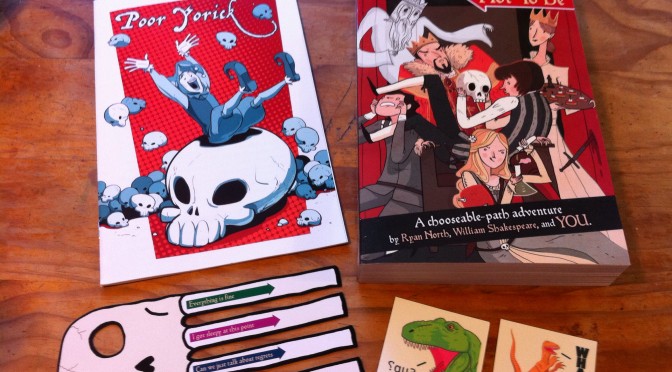“Games don’t matter,” declares Miguel Sicart provocatively in his newest book, Play Matters. What is more important, he claims, is play. Games are merely one of many forms of play, but play itself is not tied to any one object or activity. It is something much bigger; it is a way of being in the world. Of the several attributes of play that Sicart details in the introductory chapter of his book, the most salient for me is the fundamental connection between play and pleasure. Connecting play with pleasure allows analysis to shift from the cerebral, structural, and technical content of games to the heart of why we play games to begin with. To pursue pleasure is to loosen the knots of hegemonic discourse. In order to more deeply explore the relationship between play and pleasure, I will theorize adaptation as a mode of play. In order to do this, I use Ryan North’s To Be or Not To Be: A Chooseable-Path Adventure as a case study.
Locating play in the precarity of the carnivalesque, Sicart describes play as existing in constant tension “between the rational pleasures of order and creation and the sweeping euphoria of destruction and rebirth”. I believe that such tension can be exemplified, if not epitomized, by the practice of adaptation. As Linda Hutcheon has noted, one of the pleasures of experiencing an “adaptation as adaptation” is the “knowing” reader’s “conceptual flipping back and forth between the work we know and the work we are experiencing.” While both knowing and unknowing audiences will get pleasure out of a (good) adaptation, there is something affectively productive that occurs in the knowing reader’s encounter with To Be or Not To Be. By engaging the particular format of ergodic—or structurally non-linear—literature, North shows how the inherent tensions in cybertextual negotiations mimic the tensions at play in adaptation. Here, North not only plays with Hamlet, but provides a means for the reader to do so as well.

Reading the Game / Playing the Book
In the opening pages of To Be or Not To Be, North fictionally situates his own book as historically contemporaneous with Shakespeare, and celebrates it as “the earliest recorded example of ‘the books as game’ genre”. Thus, from the beginning, North’s project clearly presents itself as more than a book; it is also a game. The reader, then, is more than a reader; they are also a player.
Since To Be or Not To Be is a game, then playing it consists of the following four rules:
-
Start reading from page 1.
-
When you get to the bottom of the page, choose one of the options provided.
-
Flip to the page that corresponds to that choice and continue reading.
-
Repeat steps 2 through 3 until you get to an ending.
All of these rules are either implicit or intuitive, but they bear saying because failure to adhere to any of these rules will break the game, or to be more specific, will break the narrative. For instance, following the rules in order is important, since if a reader tries to start the book anywhere other than at the beginning, while they may be able to follow steps 2-4 without a problem, their story will lack a traditional expository beginning. Similarly, if the reader skips step number 3 and simply continues reading the pages in numerical order, or turns to a page other than the one that matches the choice they’ve made, the story will not make any narrative sense. The reader is free to break the rules in any way they wish to, and may indeed gain pleasure or meaning from doing so. But such transgressions break the game as they ignore how North has adapted Hamlet from a traditional narrative arc.
In fact, if a reader does try to ignore the rules of the game and read straight through the book in order, they immediately receive a slap on the wrist from the voice of North/the game:
Whoah, whoah, slow down there, cowboy! At the end of that last bit, you were supposed to make a choice, and then jump to the page that reflects that choice. Instead of following those instructions, you just kept reading what came next like this is an ordinary book! THIS BOOK IS CRAZY INSANE; HOW ARE YOU EVEN ACTING LIKE THIS IS AN ORDINARY BOOK??
The reader thus immediately encounters tension between their own control of the story and the control of the author. Although the entire premise of the book is that the reader is permitted to make meaningful choices that will lead them through relevant storylines, the recurrence of North’s authoritative authorial voice reminds the reader of the futility of their choices, since North can, at any time, divert the track the character is on if he does not approve of their choices. This point is also evident in the game-like representation of the book, but significantly, as an absurd and possibly broken game. North’s frequent references to character stats and point values, ultimately have no significance whatsoever, as there is not only no means of tracking such information, but there is also no means of using such aspects during gameplay.

If rules 1-3 are important, then rule 4—playing through to an ending—is essential. That is to say, if the reader simply stops reading at an arbitrary point, then their story won’t have an ending. This is significant in that it represents narrative resolution as a game goal. The “win condition” thus serves as incentive for the player to play multiple times and to make particular choices in an effort to arrive at a particular ending. Which ending(s) is of course up to the individual player and largely contingent upon their individual play style: do you want your character to die? To get married? Do you want to find your way through the labyrinthine structure in order to arrive at as many endings as possible?
Of course, the game blocks certain attempts at circumnavigating the system by not providing a way to trace backwards from any page. Also, if a reader flips directly to the last page of the book, North’s voice taunts again, “Hah hah, nice try champ! Opening the book to the last page to see how the story ends isn’t gonna help you out with this little volume of non-linear branching narrative structure!!”. This is not to say that someone can’t “cheat” by simply flipping through the book and just looking for all of the readily identifiable endings, but the endings themselves as end goal reward are by no means the only incentive for the player to play the game. Rather, the pleasure of finally arriving at one of those endings is derived from both the experience of play as well as from reading through the full story arc that gets them there as an adaptation of Shakespeare’s Hamlet.
The negotiation that thus occurs throughout the game between the player and North is what makes this ergodic text specifically a cybertext, by Espen Aarseth’s definition. I would argue that these moments of negotiation are what make cybertexts pleasurable, and by reflexively and deliberately exacerbating these moments, North pumps up the volume of that pleasure. After all, the stakes are high: “Trying to know a cybertext is an investment of personal improvisation that can result in either intimacy or failure.” Since tension and precarity are central to Sicart’s theory of play, it follows that it is precisely in that tension—the possibility of achieving either intimacy or failure—that pleasure is rooted. For the knowing reader of To Be or Not To Be, the pleasure is the result of the dangling carrot of the possibility of wresting the text away from Shakespeare and its perpetual elusivity as North takes it back again. Because ultimately, after all is said and done, it is merely an illusion that the reader has any control at all: this is North’s game.

Whose story is it?
Significantly, North does not shy away from his authorial power. Rather, he revels in it.
In the first sentence of the book North outs Shakespeare as a plagiarist, and suggests that “the famed play William Shakespeare Presents: Hamlet! was lifted wholesale from the volume you are about to enjoy, To Be or Not To Be”. Following from this point, North lays bare the fact that the player’s interactivity with the text is inherently impotent, and actually provides the choice to not choose your own narrative path and follow instead “the choices Shakespeare himself made when he plagiarized this book back in olden times.” This path is designated by “tiny Yorick skulls” near the bottom of the page where the choice is offered. After selecting a character, interested players can read straight through the book on autopilot. This results in a “straightforward” adaptation of Hamlet, as written by Ryan North, with minimal interactivity on the part of the reader. But of course, even these storylines are by no means straightforward. Ophelia and “Hamlet Sr.”, for example, don’t get very far.
If a reader attempts to play this way as Ophelia, they will find the choices presented are far from neutral; after Laertes and Polonius offer her condescending advice about her relationship with Hamlet and call her slutty and dumb, Ophelia is eventually offered the choice to either “Slap [Polonius] across his face and tell him you’re not dumb and you can recognize sincere emotion in a sexual partner when you see it”, or to:
Tell him – you’ll obey? And then call him your lord. And…follow him meekly out of the room? Agree with everything he and Laertes have said, because all that stuff I wrote earlier about you being an independent woman in charge of her own destiny sounds PRETTY DUMB ACTUALLY, and you’d better do whatever someone else tells you to, because anyone other than you probably knows better about your own life than you do, right? Look, I am now trying to think of the dumbest thing you can do. Please, I beg you, do not choose this option.
If the reader follows the second option (the one with the Yorick skull), they are told that they are no longer allowed to be Ophelia, and are given only one option: to continue playing as Hamlet.
But Hamlet is by no means immune to criticism from North either. Although Ophelia and Hamlet Sr. may not have particularly long lifespans in the “Shakespearean” choice tree, Hamlet is constantly berated for following the “original” choices. For example, after the infamous “get thee to a nunnery” scene, Ophelia asks Hamlet why he is making such cruel and sexist comments, and North chimes in to say he thinks it’s a pretty good question. If Hamlet then proceeds to make the “Shakespearean” choice to “Say ‘Women are idiots who just want to get a sexing’”, on the following page North almost audibly sighs and shakes his head as he remarks, “Sometimes I wonder why I give you these choices”.
North at no point pretends to be invisible, and in doing so, highlights the frustrating moments of negotiation in his cybertext. Here, the process of storytelling is clearly understood to be collaborative, but in tension as such. The tension between North and the reader intersects with the tension between North and Shakespeare. That is to say, adaptation, as a mode of play, is carnivalesque in that it epitomizes “a dance between creation and destruction, between creativity and nihilism”. Alongside North, the reader participates in a tug-of-war between destroying Shakespeare and building something new.

Pleasurable Precarity
For the “knowing” Shakespeare enthusiast, the pleasure of To Be or Not To Be resides in the remaking of Hamlet in a mode that expresses criticism of its sexist themes, obnoxiously immature protagonist, unrealistic plot points, and plain boringness. The cultural icon of Shakespeare, so often held up as sacred and untouchable, may be examined and critiqued through play. Here, adaptation (as a mode of play) “takes control of the [“work”] and gives it to the [player] for them to explore, challenge, or subvert”. The gamebook structure draws the reader into a collaborative and participatory mode of adaptation that emphasizes that Shakespeare is not beyond all criticism.
But, of course, neither is North. In fact, To Be or Not To Be is a prime example of the impossibility of “truly” interactive text, since the finite options from which the reader/player has to choose are still designed by the author/designer. For instance, in the scene quoted above where Ophelia is chided for letting her father and brother make her life choices for her, although it ostensibly offers a feminist reclaiming of Ophelia, is not completely free of problematic elements. Not all women are equally empowered to make choices such as this, and it is therefore unethical and harmful to place blame on the victim. But on the other hand, in this space North speaks to the reader, rather than to Ophelia, emphasizing, at the very least, that making the choices that Ophelia was originally given by Shakespeare do not lead to a particularly thrilling storyline for Ophelia.
But what North does particularly well, and what is unique about this text, is his deliberate and irreverent engagement with those tensions. Incidentally, it is precisely this tension that serves to reify the original “work” that is Shakespeare’s Hamlet, according to Shakespearean scholar Margaret Jane Kidnie. For her, authenticity is not an essential and inherent trait in the author’s mind or a singular text, but is rather defined by a networked group of users through the process of designating all those things that are adaptations. These two designations are flexible, therefore, and contingent upon temporal, geographical, and social contexts. Playing through adaptation allows us to straddle this pleasurable line between “work” and “adapation”, and to resist a bourgeois ideology of taste that insists that only certain works count as legitimate.
–
Featured image “Hee! Hamlet, choose your own adventure style :-),” by mimbles @ Flickr CC BY-NC-SA.
–
Emma Leigh Waldron, is a Doctoral Student at UC Davis in the department of Performance Studies and a graduate of the MA Performance Research program at the University of Bristol, where her thesis was entitled: “Beyond Binaries: Questioning Authentic Identity in Hedwig and the Angry Inch“. Previously, Emma studied Performance Studies at New York University, and earned her BA at Rutgers University where she studied English, Art History, and Theater Arts.
Emma is a theater artist, larp organizer, and researcher who is interested in exploring performances of intimacy and the intimacy of performance. Emma’s research focuses on the affective power of performance, the intersection of sex/gender and performance/play, and in exploring where the boundaries of performance (and the perceived “inauthentic”) begin to dissolve. Through her work about what it means for the body to perform and be performed upon, she attempts to explore the reciprocal relationship between performance and affect and how, why, and if we can perform intimacy. Emma sees performance as a particularly powerful tool for feminist and queer activism. Her research interests revolve around the exploration of identity, sexuality, immersivity, and embodied knowledge, and she is particularly interested in the ways in which these issues are challenged and played with through the practices of larp, porn, and drag.

